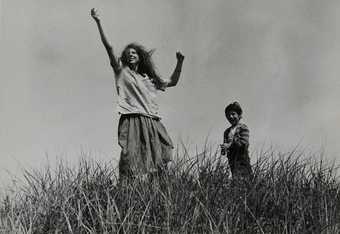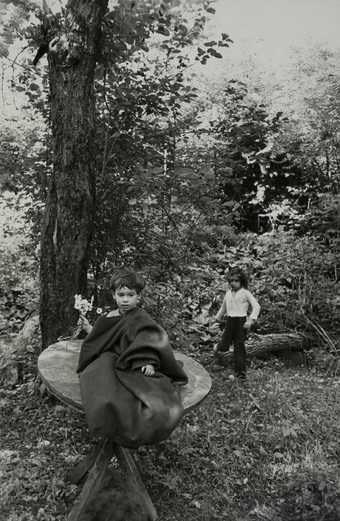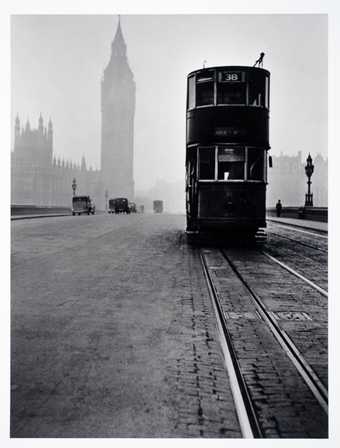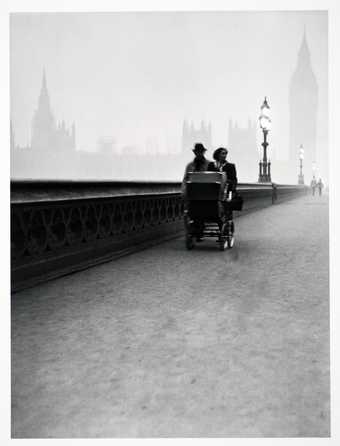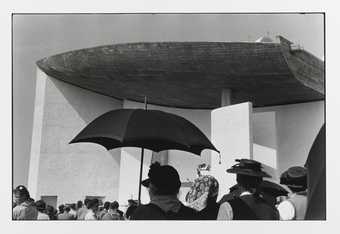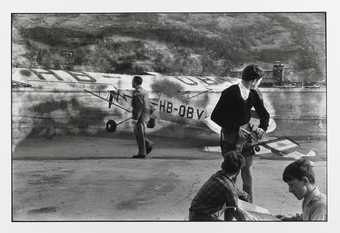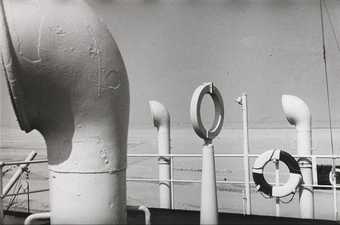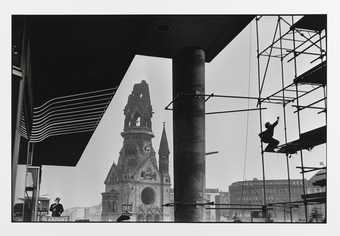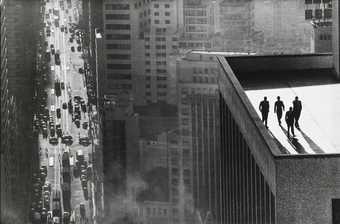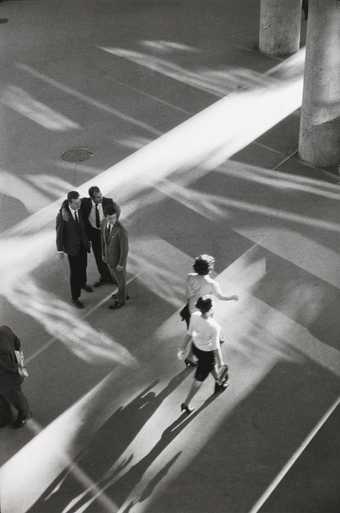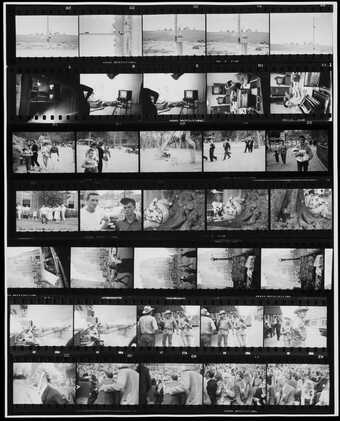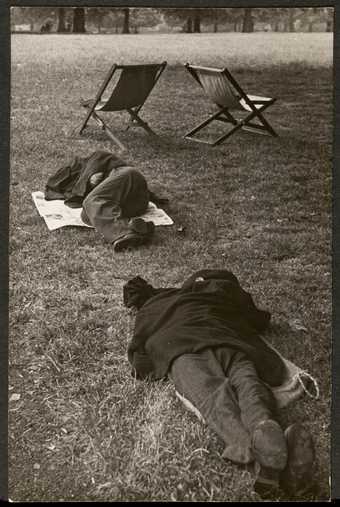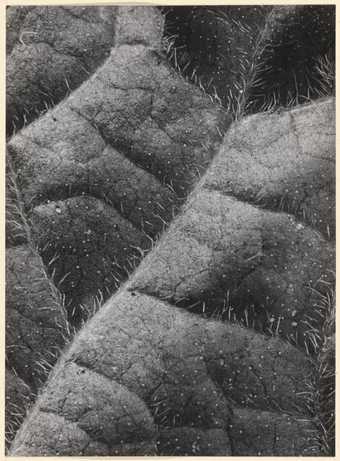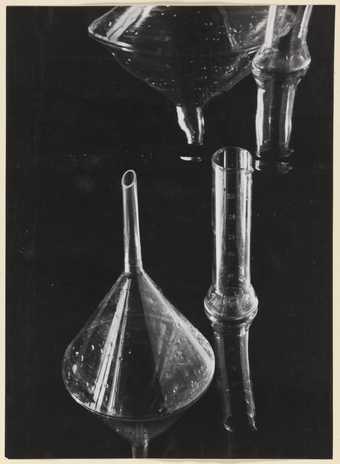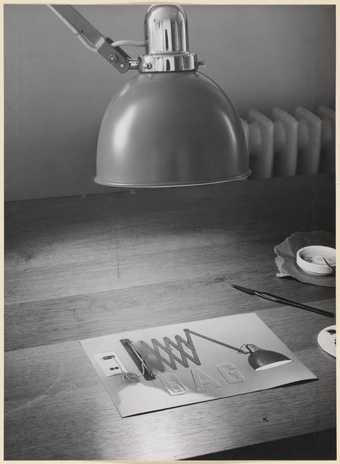
In Tate Modern
- Artist
- Werner Bischof 1916–1954
- Medium
- Photograph, gelatin silver print on paper
- Dimensions
- Image: 226 × 167 mm
- Collection
- Tate
- Acquisition
- Presented by Tate Patrons 2014
- Reference
- P81106
Summary
Crate with Cardboard 1933 is one of four black and white photographs in Tate’s collection taken by the Swiss photographer Werner Bischof (Tate P81105–8). It depicts a composition of a seemingly discarded piece of corrugated cardboard on top of a beaten wooden packing crate. The crate bears the name of the place of origin (‘Lausanne-Gare’ – Lausanne Station) and destination (‘Zürich-Hbf [Hauptbahnhof]’ – Zürich Main Station).
The four photographs were taken between 1933 and 1936 when Bischof was either still a student at the Zürich School of Arts and Crafts or in the early period of his studio practice, and so pre-date his more well-known documentary work. They depict everyday objects with the aim of exploring their formal qualities and structures. The variety of objects and approaches references Bischof’s desire at the time to experiment with and master different photographic and darkroom techniques, often with an eye on commercial work and advertising (see Untitled 1934, Tate P81108). Underside of a Leaf 1933–6 (Tate P81105) is one of many images of botanical and natural forms Bischof photographed as part of this exploration, and demonstrates his ability to use directional studio lighting to attain various levels of sharpness, detail and tonal gradation. The play of reflected light and shadow in Untitled 1934 (Tate P81107) evidences Bischof’s experimentation with formal composition, while the graphic style of Crate with Cardboard 1933 (Tate P81106) resembles the layering effects seen in collage and photomontage popular during this period. While working in his studio on advertising, commercial and fashion projects, the exploratory photographs Bischof produced during this period aligns him with other pre-Second World War modernist photographers such as Werner Mantz (see Portfolio 1927–35, Tate P79940–9), Aenne Biermann (see Ceramic Cup c.1929, Tate P80261), and Iwao Yamawaki (see Untitled (Composition with Bricks, Bauhaus) 1930–2, Tate P79898).
Werner Bischof began studying photography in the early 1930s, going on to build up a successful studio and publish work for various magazines including Du in Zurich. His practice can be divided into two distinct chapters – his time as a student and studio photographer in the 1930s; and his post-war years as a prolific documentary photographer, travelling extensively in Europe, India, Japan and Latin America. Bischof was the fifth member of the cooperative picture agency Magnum Photos, joining in 1949.
Further reading
Claude Cookman, Werner Bischof, London 2001.
Marco Bischof, Questions to My Father, London 2004.
Shoair Mavlian
July 2013
Arthur Goodwin
March 2019
Does this text contain inaccurate information or language that you feel we should improve or change? We would like to hear from you.
Display caption
Crate with Cardboard depicts a seemingly discarded piece of corrugated cardboard on top of a beaten wooden packing crate. The crate bears the name of the place of origin (‘Lausanne-Gare’ – Lausanne Station) and destination (‘Zürich-Hbf [Hauptbahnhof]’ – Zürich Main Station). Bischof was interested in the formal qualities, structures and textures of everyday found objects. The graphic style of the photograph resembles the layering effects seen in popular collage and photomontage works of the 1930s.
Gallery label, January 2022
Does this text contain inaccurate information or language that you feel we should improve or change? We would like to hear from you.
Explore
- emotions, concepts and ideas(16,416)
-
- formal qualities(12,454)
-
- photographic(4,673)
- texture(466)
- miscellaneous(732)
-
- cardboard(1)
- label(43)
- crate(27)
You might like
-
Robert Frank Mary and Pablo in high grass
c.1956 -
Robert Frank Pablo holding flowers with a girl
c.1956 -
Rene Groebli Tram on Westminster Bridge
1949, printed later -
Rene Groebli Untitled
1949, printed later -
René Burri Inauguration of the Chapel of Notre-Dame du Haut, France, 1955
1955, printed 2014 -
René Burri Valais Canton, Switzerland, 1956
1956, printed 2014 -
René Burri Suez Canal, Egypt, 1956
1956, printed 2014 -
René Burri The Kaiser Wilhelm Memorial Church Bombed During the War and Never Restored, Berlin, Germany, 1959
1959, printed 2014 -
René Burri Sao Paolo, Brazil, 1960
1960, printed 2014 -
René Burri Ministry of Health by Architect Oscar Niemeyer, Rio De Janeiro, Brazil, 1960
1960, printed 2014 -
Robert Frank Contact Sheet from The Americans
1955–6; printed 1970s -
Horacio Coppola Hampstead Heath, London
1934 -
Werner Bischof Underside of a leaf
1933–36 -
Werner Bischof Untitled
1934 -
Werner Bischof Untitled
1934

